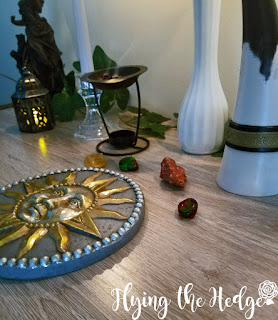Litha or Midsummer Solstice celebrates the Sun's peak in strength when it appears to hang still in the heavens. For colors I focused on yellows, oranges, reds, and golds, masculine colors and the color of fire and light.
Lets start on the left side which is the Eastern side of my altar (my altar faces South). I have some cinnamon incense which combines an herb of the Sun with fire, making it the perfect representation of the Sun rising in the East. Next to the incense is my statue of Mother Earth, who represents the feminine. She is next to the incense because the Sun rises over the Earth, or appears to due to the Earth's planetary movements.
Next I have an array of candles and lanterns. The lights and flame represent fire, light, and thus the Sun. Litha is the longest day of the year and the Sun is at its peak, making a number of candles very fitting on any Midsummer altar.
Next to the candles is a solstice incense I picked up from a local herb shop at the Renaissance Festival this year. It doesn't say what it contains, but based on the smell I am certain cinnamon is included. Like the candles, incense use fire, making it useful for representing the Sun.
In the middle is a mix of flowers including sunflowers and white and yellow daisies. The sunflowers with their yellow color represent the Sun and happiness while the daisies represent joy and lust.
The horn, which first appeared on my Beltane altar, represents the masculine. You can't have a Midsummer altar without honoring the masculinity of the Sun. Behind the horn is ivy, a symbol of health and abundance, represents the lush greenery characteristic of this time of year. Trees, shrubs, and plants are full and green by the end of June.
Finally, on the far right, which is the western side of the altar, I have a glass terrarium. Glass combines the elements of fire and earth, thus representing the Sun setting in the west. I kept the terrarium empty at this time because I did not have any small plants on hand that I felt would work with this particular altar. Maybe next year.

In front of everything are four crystals: amber, malachite, red calcite, and bloodstone. Amber, according to ancient myths, are tears of the Sun. Its golden yellow color represents not only the Sun but strength and courage as well. The malachite represents abundance and protection. The red calcite represents strength, while the bloodstone represents health. The reds and yellows of these stones go with the summer theme.

Finally my beautiful Sun plaque. Sitting in the center of the altar, it pulls the entire set up together, showing that everything revolves around the Sun.

I hope everyone enjoys the Sunlight today. Get outside, eat good food, and spend time enjoying the Sun's day of power with family.





Huh, I notice your altar dissection and reviews look awful familiar. You should find your own voice! Blogging is a fantastic opportunity for that.
ReplyDeleteMy altar dissection is inspired by yours and other pagan bloggers who do similar things. I like the general set up and feel it conveys the information best.
DeleteI understand that and I'm flattered, but your format for some of your posts are becoming increasingly similar to mine - to the point that I've been getting messages about a "copycat blogger." You might consider reworking your posts to something more original.
DeleteI'll keep that in mind and reformat future posts to avoid confusion. I still plan on labeling my altars, and I hope that is fine with you. I'm not trying to be a "copy cat" blogger. I am simply giving my readers what they have asked for. I have received 10 emails in the past 6 months asking for altar posts, so I started putting them together.
DeleteAs for the review posts, I think you are referring to my subscription box reviews. I started reviewing Crate Joy subscription boxes last year, which I shared with you when you reviewed the Box of Shadows. You ended up using a format almost identical to what I had been using, but I removed anything similar to yours yesterday to avoid anyone thinking I was "copying" you. The format that we both used is the same the majority of subscription box reviews use and have used since these boxes took off a couple years ago. I'd rather not, however, have people thinking I "stole" your reviews because that is far from the truth. If you check under my tab "Witch's Cabinet" you will see a number of reviews starting last October. As I mentioned, I removed my overall pro and con list on the three month mark posts for each box because that was the only part you did that was similar to what I had already been doing.
Apart from my altar posts, I do not post anything remotely similar to what you do. I avoid topics you tend to cover as there is no point in recovering the same information if someone has already done so and link to the information if I mention it in another post. I hope you will spend some time actually looking through my content and you will find we are two very different bloggers.
I understand that I started reviewing Cratejoy after you, but that's only because I was approached by Karen at Cratejoy to do so. I don't purchase items or services for review. If someone wants a review, they offer me a free subscription or a free box and, in exchange, I review it. That being said, I was reviewing Sabbat Box for a full year starting with Beltane 2015 and the format for Cratejoy does bear a striking resemblance to my own for Sabbat Box. That's why I started adding pros and cons to the posts - to try to separate my reviews from yours; that is, until you started doing it too. You can certainly see the concern and confusion that that might bring and why I've been getting messages about it.
DeleteIn terms of labeling altars with the arrows and descriptions, I have yet to see another blogger do that and it almost inevitably links readers back to my blog. The format is rather unique. That being said, I'm not going to police what you can and can't use. I'm just bringing it to your attention that readers - at very least, readers of mine - are noticing that it's a mimic of my own posts.
I'm aware that you post other content outside of what I post, hence why I've said "some posts" in my original comment. I've only stated what I've seen and what I've been linked to in e-mails and messages sent my way. I want you to be a successful blogger, truly, but I don't think success on the curtails of someone else's hard work is ethical. Simply something to consider. Best wishes to you!
I had a pros and cons list on my three month mark reviews for December's Box of Shadows (which I think posted January 1?) and the Gaia Collective's June Moon Box. I don't feel 1 month is long enough to adequately review a subscription box hence why it was not in the other reviews for the same boxes. But its cool. I removed the lists. I don't want anyone thinking I am copying or to add to confusion. I read some of your Sabbat Box reviews. You focused on price points for each box, if I recall. I don't remember a pros and cons list, but maybe I missed the post. I just use the format I use to take notes; its quick and easy to translate into posts. I can just include my pros and cons within the paragraphs instead of making a list. That's fine.
DeleteI've seen several arrow labeled altars on Pinterest that are not yours. Yours have a very striking appearance; there is no doubt they belong to you, even the first few you did have your distinctive touch. I'll change the format to limit confusion. I don't mind. I've been playing around with the design every time I create one to figure out exactly how I want to do to label them. I'm not happy with them just year. Perhaps numbers like on a paleontological or botanical drawing. I donno. I'll figure it out by Lammas.
And thank you. I wish you the best of luck too! I know you are trying to turn blogging into a full time career. I hope you are able to succeed. BTW, did you raise enough money for a new camera? I tried to find the post a couple weeks ago because I had some extra cash, but was unable to find it. If you haven't, mind posting it or sharing it on Facebook?
What a beautiful altar! Happy Litha.
ReplyDeleteThank you!
Delete